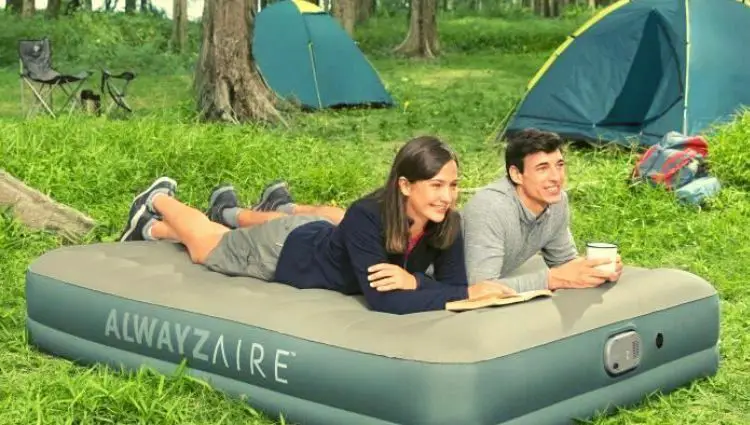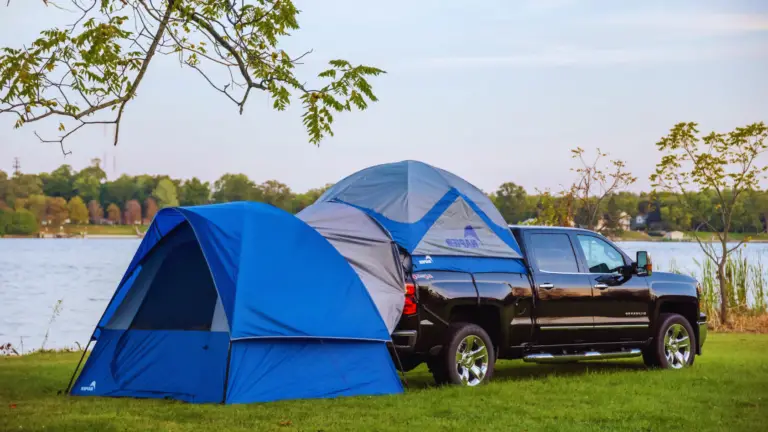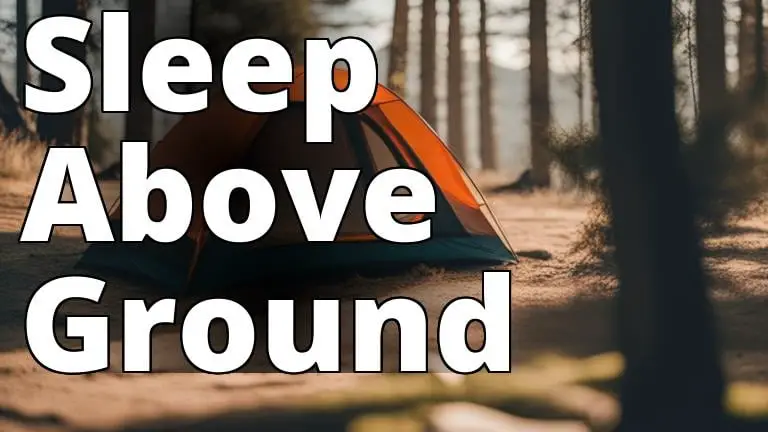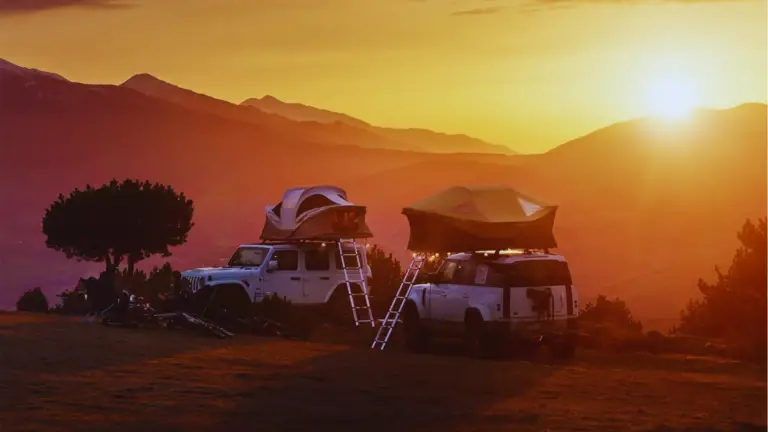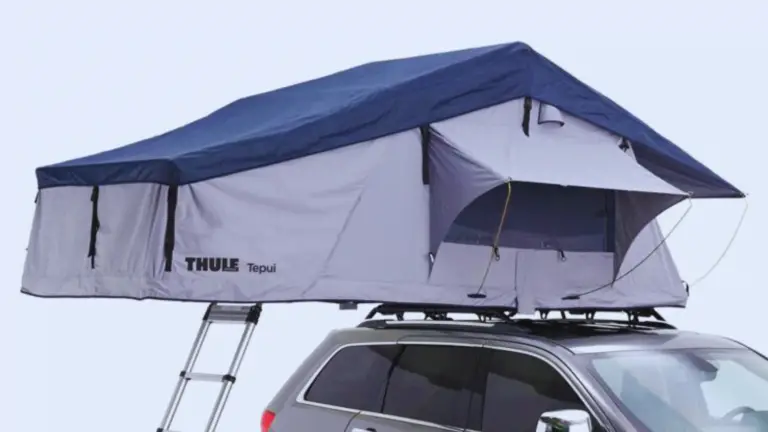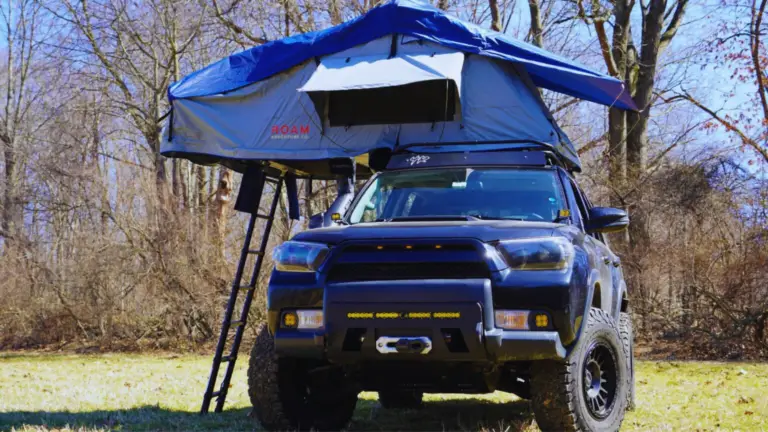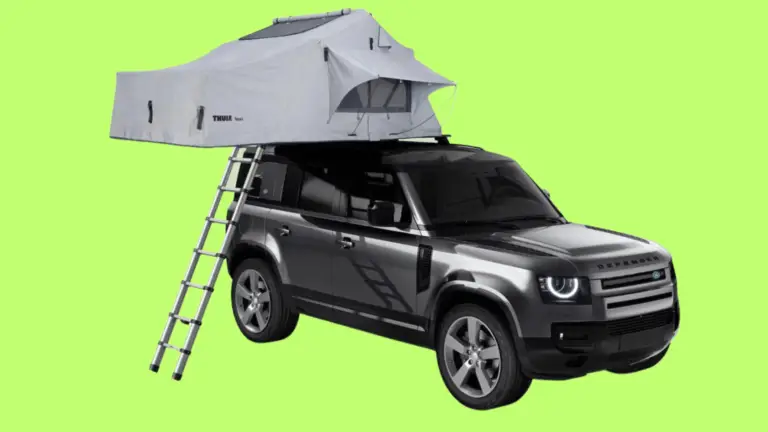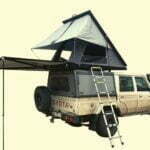There are several advantages to camping in a car. You can relax and appreciate nature without worrying as much about carrying too much stuff. This paves the way for upgrading to a plusher mattress pad. These are the best automobile camping mattresses and pads, ranging from a very cushioned double sleeping pad to our budget selection.
Not everyone has the same requirements for their sleeping pad, so we’ve organized these products into several groups to make it easier to locate the one that best fits your needs.
Pads designed for use in automobiles and similar situations are the topic of this roundup. We did not try out any pads or mattresses that could be stuffed into a backpack. Check out the goods we recommend if you’re in the market for a hiking pad.
You may either scroll through all of our top picks or directly to the section you’re interested in. Here is a table detailing the product specifications so you may compare them side by side.
Table of Contents
ToggleCamping Mattresses: Comparisim
Therm-a-Rest MondoKing 3D
Our ratings
- Weight: 5 lbs., 8 oz.
- Product Dimensions 78.74"L x 25.2"W x 4.33"Th
NEMO Roamer XL Wide
Our ratings
- Weight: 5 lbs., 8 oz.
- Product Dimensions: 78"L x 30"W x 4"Th
Exped MegaMat Duo 10
Our ratings
- Weight: 9 lbs., 14 oz.
- Product Dimensions: 9.6"L x 5.5"W x 22.3"Th
Sierra Designs Air Bed
Our ratings
- Weight: 5 lbs., 6 oz.
- Product Dimensions: 77.9"L x 55.9"W x 10.2"Th
Sea to Summit Camp Plus SI Sleeping Pad
Our ratings
- Weight: 2 lbs., 11 oz.
- Product Dimensions: 78"L x 25"W x 3"Th
Kelty Mistral SI Sleeping Pad
Our ratings
- Weight: 2 lbs., 12 oz.
- Product Dimensions 74"L x 23"W x 1.5"Th
Kelty Tru.Comfort
Our ratings
- Weight: 4 lbs., 10 oz.
- Product Dimensions 74"L x 23"W x 4.75 in.
Coleman Self-Inflating Camping Pad With Pillow
Our ratings
- Weight: 3 lbs., 4 oz.
- Product Dimensions: 27.6"L x 7.1"W x 7.1"Th
The Best Camping Mattresses & Sleeping Pads: Review
1. Therm-a-Rest MondoKing 3D
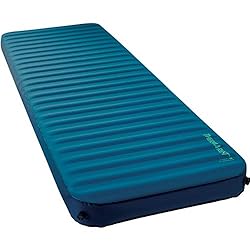
You won’t know what you’ve been missing until you lay down on this ($230-$260) mattress pad. You’ll have plenty of room to stretch out, as well as all the heat and cushioning you could ever want. You can roll around in your sleep without worrying about falling off thanks to the 20% more space the bed’s vertical sides provide.
Easy inflation is ensured by two separate valves. We also appreciate how easily it opens up for rapid deflation. Putting it in the tote bag will need several tight rolls, but it can be done.
This pad’s longevity stands out in addition to its comfort and warmth. More over 200 nights of use, and it’s still functioning perfectly.
It has survived a leaping, rambunctious child, overnight use by an adult, and direct contact with gravel and other uneven surfaces. Everything that could happen to it has happened, yet it has stayed perfectly inflated and comfortable the whole time.
The big size of this pad costs $230, making it more affordable than the Camp Dreamer but less durable than the NEMO Roamer. You’ll need to prioritize one of these considerations, though. You can count on the MondoKing 3D to keep you warm and comfortable on trips you haven’t even thought of yet.
What we like
- Warm.
- Thick.
- Luxurious.
- Robust.
What we don't like
- Initial inflation is more difficult than with other competing pads.
2. NEMO Roamer XL Wide
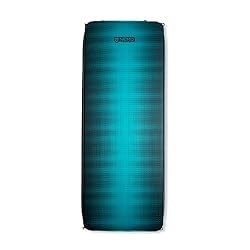
The NEMO Roamer ($250) is a must-have for anybody who has ever made their automobile their home. Camping mattresses don’t get more luxurious or convenient than this one, and neither do adventures. It’s substantial, keeps you toasty, and is wonderfully cozy. Four inches of open-cell foam can make any place seem like home.
Like other self-inflating pads, this one has to be topped out before use. Adding air, however, is a breeze thanks to the microadjust valve, which prevents air loss throughout the process. We also appreciated how easy it was to deflate the pad completely using the one-way valves when it was time to leave camp.
The Roamer’s 75-denier polyester bottom and foam structure make it far more durable than a standard air mattress when used for outdoor camping. Toggle connections on either side of the Roamer make it possible to join two of them together to form a double-sized bed.
Although it is not lightweight, its relatively compact packing size is well worth the extra convenience it provides. It is about the size of a winter sleeping bag, or 10 x 16″.
After over 150 nights of use, this pad stopped being airtight. We had to keep topping it off every night since the valves started a steady leak. It might not be the best option for someone who plans to live in a car or van full-time. For someone who likes to explore by automobile and sleep in a tent, however, we wholeheartedly endorse it.
What we like
- Comfortable.
- Last longer.
- Fits together with another Roamer pad to form a larger bed.
What we don't like
- Expensive.
- In time, a valve will leak.
3. Exped MegaMat Duo 10
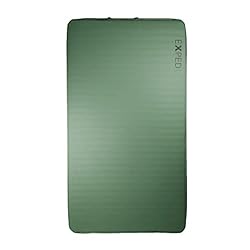
MegaMat ($330–$450) prioritizes comfort. Size and comfort compensate for compactness and pricing.
Foam cushions and insulates. The MegaMat Duo is a pleasant alternative to standard double sleeping mats, which send one partner flying if the other moves.
After lengthy use, self-inflating pads must be re-inflated. The included pump makes inflation simpler than blowing into it. Even though it’s quite durable, it comes with a repair kit.
Our lodging’s flatness is a favored characteristic. Unlike other camping mattresses, this one stays flat even after frequent usage.
The MegaMat is 77.6 inches tall and 52 inches wide, so one adult can sprawl out, or two may snuggle. Double-sized, fitted sheets fit snuggly.
Our expert reviewer remarked, “The vertical sides enhance the useful sleeping surface.” This pad’s added functionality is immediately noticeable. These sidewalls increase comfort and spaciousness and keep you dry in harsh weather.
Mother Nature rained for three days straight. Wet tent flooring because of my height and larger surface area, I kept warm.
This strong, comfortable, and big double sleeping mat is the finest you can get. You can buy the track here.
What we like
- The pinnacle of ease and relaxation.
- Durable.
What we don't like
- Packing capacity is rather large.
- Expensive.
- Heavy and bulky.
4. Sierra Designs Air Bed
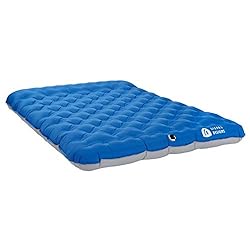
Designed to sleep two, Sierra Designs’ $60 air mattress is an excellent value in the world of camping beds. Although it’s not as compact as something like the MegaMat Duo, we still found it to be a pleasant sleeping experience when on the go. It can accommodate two people sleeping comfortably on queen-size linens.
It takes some time to completely inflate with the accompanying battery-operated pump, but it does a fairly nice job. This air mattress has withstood months of use, even when placed on the floor.
Although it is not as warm as some of the other pads on our list, it is still one of the finest budget camping mattresses out there.
What we like
- Convenient.
- PVC-free.
What we don't like
- It's not as comfortable as the big air mattresses.
- No insulation was present.
5. Sea to Summit Camp Plus SI Sleeping Pad
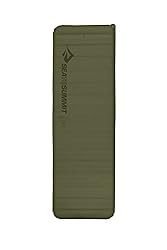
We think you’ll find a lot to love about this place. You can get 3 inches of self-inflating support for less than $100 (or $90 for the standard model). Just a few months into testing, and so far, we couldn’t be happier with the results.
It’s quite fluffy, however not quite as soft as a thick pad like the MondoKing. Those of us who prefer to sleep on our sides feel the same way.
Warm sleep is guaranteed thanks to the 4.3 R-value of this camping mattress, allowing its usage in all seasons (paired with the right sleeping bag). There is a clear difference between this mat and its predecessors in terms of thickness and comfort.
The durability of the Camp Plus SI was likewise well regarded. The outside fabric is 75 denier, making it pleasant to the touch while still being durable enough for everyday usage. No wear or tear has occurred despite our using this pad without a ground cloth in a tent or on the ground.
The flip-over valve arrangement used by Sea to Summit is another nice touch. For inflation, it makes a one-way flow, and when it’s time to deflate, it may be withdrawn entirely. This cushion weighs roughly 3 pounds, making it ideal for car camping mattresses but also usable for limited periods of trekking.
The “Pillow Lock” feature is a great addition to the Aeros Camp Pillow. Simply attaching the pad and pillow together with a small amount of hook and loop can assist keep your pillow in place.
What we like
- Comfortable.
- Simple inflation/deflation is ensured with reversible valves.
What we don't like
- Heavy.
- Pricy.
6. Kelty Mistral SI Sleeping Pad
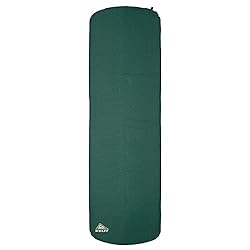
At $45 (a steal), the Mistral SI is a must-have. It’s a steal to get a high-quality mattress pad for around $50. Nonetheless, it’s hardly the plushest pad out there, at only 1.5 inches thick. There was never a time when we could feel the floor beneath us, but it is noticeably thinner than the other pads and camping mattresses here.
Choose a thicker mat if you want to sleep in the utmost luxury. However, this is the best option if you want a sturdy mattress that won’t break the bank.
Simple inflation and deflation are hallmarks of the mistral. There’s nothing spectacular about it, but it does what you need it to accomplish and has no serious drawbacks. Even when temperatures dropped into the 20s, we were toasty because of the insulation’s thickness (with a good sleeping bag, of course). It’s worth noting that this pad only comes in a standard length, so if you’re really tall, you may want to look elsewhere.
It folds down to a manageable size and weighs only 2 pounds, 12 ounces. We’ve taken it along on shorter hike-in camping trips, but it’s too bulky to bring along on longer hiking trips.
You can’t go wrong with this sleeping mat if you’re just starting out in camping or are on the hunt for a bargain.
What we like
- Reasonably priced.
- Packable.
What we don't like
- Not as cozy as other bed options.
7. Kelty Tru.Comfort
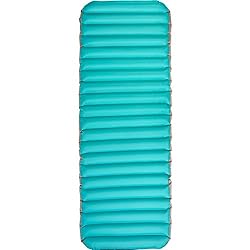
While the Tru. Comfort ($90) is a pleasant camping mattress to sleep on, we had hoped for more features. All right, let’s start with the good things.
It’s thick enough (4.75 inches) to keep people who sleep on their sides off the floor all night. The compression sack may be used to inflate the sleeping pad, saving time and energy. In general, it’s a solid and simple air mattress.
We just wish there was a bit more foam insulation considering the cost. Because of this, it would be not only warmer but also more comfortable and usable in a wider range of climates and seasons.
What we like
- The inflated bag is perfect for use as a stuff sack.
- Thick.
What we don't like
- Just not as cozy or comfy as some other camping beds out there.
8. Coleman Self-Inflating Camping Pad With Pillow
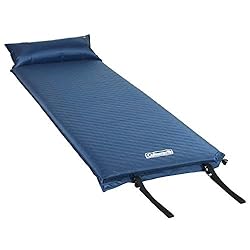
Inexpensive sleeping camping mattresses and pillows that double as a tent are hard to come by for the occasional camper, but you can get both for about $60. Even if Coleman’s version isn’t the most luxurious, it’s a good choice if you only plan to camp a few times a year or are on a tight budget and want to give camping a try.
There will likely be a need to give the pad a final burst of air to fully inflate it. The accompanying cushion, if used, must also be inflated.
Weighing in at just over 3 pounds, it’s not too cumbersome to go along on a road trip. Because of its 76-inch length, it is also a suitable choice for those who are over average in height.
The pad itself is OK; however, the straps that come with it are flimsy and often come apart at the rivet. An inexpensive option if you won’t be using the straps often.
What we like
- Inexpensive.
- Ideal for tall campers.
What we don't like
- Worries about its longevity.
- Not as cozy as other bed options.
How to Choose a Camping Mattress (A Buyer's Guide)
A luxurious air mattress, such as the Hest Sleep System, or a cushioned, inflatable choice, such as the NEMO Roamer, will provide you with the most comfort if you plan on spending most of your time in a car while camping. These have the drawback of being too bulky and heavy to be used in a backpack.
Hiking into the bush calls for a cushion that can be compressed and carried easily. However compact and lightweight you’d like to make your setup is entirely up to you. The Therm-a-Rest NeoAir UberLite is lightweight and compact, weighing in at only 8.8 ounces. It can be compressed to the size of a soda can.
Comparing Mattresses and Pads
There is a lot of room for interpretation when deciding whether or not to use an air mattress vs a sleeping pad. Items on this list that are thicker, cozier, and less portable are referred to as air mattresses. The HEST Sleep System is a mattress in every sense of the word, being 7 inches thick and 26 pounds.
Portable sleeping mats are thin, light, and easy to transport. While most of the items on this list are designed for use in a car, there are a few, such as sleeping mats, that are compact enough to bring on a river trip or a short hiking trip. One very adaptable sleeping pad is the Sea to Summit Camp Plus SI.
Mass and Dimensions when Packed
A luxurious air mattress, such as the Hest Sleep System, or a cushioned, inflatable choice, such as the NEMO Roamer, will provide you with the most comfort if you plan on spending most of your time in a car while camping. These have the drawback of being too bulky and heavy to be used in a backpack.
Hiking into the bush calls for a cushion that can be compressed and carried easily. However compact and lightweight you’d like to make your setup is entirely up to you. The Therm-a-Rest NeoAir UberLite is lightweight and compact, weighing in at only 8.8 ounces. It can be compressed to the size of a soda can.
Comfort
The thicker the mattress, the more pleasant it will be. Adding some foam or additional insulation may also improve the quality of life and lessen the amount of noise.
If you sleep on your side, you know how important it is to have a pillow or two beneath your hips and shoulders. A thicker sleeping mat is recommended for a more comfortable night’s rest.
Durability & Denier
Denier is a measuring unit for the strength of textiles and is directly related to their longevity. A greater denier number indicates a thicker and tougher textile. This is crucial for a sleeping mat since it will prevent punctures.
The Therm-a-Rest NeoAir UberLite is constructed with 15-denier nylon at its lightest point, making it ideal for backpacking trips. When comparing this to other options, remember that the NEMO Roamer uses 75-denier polyester. You probably already know that strength and lightness are not always compatible.
Price
A fair price is very important to us. But what we value most is equipment that serves its purpose well and can be used for more than one season.
An inexpensive tent may suffice if you just intend to spend a few nights under the stars each year. However, it is prudent to spend extra on a sleeping mat if camping is a frequent event.
This lays the groundwork for a restful night’s sleep, and if you receive enough of it, you’ll find that spending the day outside is more pleasurable. Paying a little more usually results in improved convenience, longevity, and thermal insulation.
Warmth & R-Value
A decent camping pad should not only provide soft padding, but also some insulation from the cold, hard ground underneath. The more thermally insulating and comfortable a mattress pad is, the greater its R-value. Due to its massive 9.5 R-value, the MegaMat is perfect for use in all seasons of vehicle camping.
Whether you sleep warmer or cooler than average can have a small effect on the required R-value. A sleeping pad with a rating higher than 5 is recommended for use during the winter months. Something between two and four should do the trick for warmer summer nights.
Choose a warmer sleeping pad if you frequently wake up with a cold back, or layer a foam pad like the Z-Lite on top of your regular pad for further insulation.
Length & Width
Both standard and extra-long lengths are available for camping mattresses. Additionally, there are short, broad, and long lengths available for some. Your length and breadth requirements for a camping trip are determined by both your body measurements and your intended activities.
In order to save a few ounces of weight, we’ve heard of tall thru-hikers slicing their Z-Lite pad in half. We also have some little testers that want to roll about as they sleep, so they need a broad pad.
The most important thing to keep in mind is that as the dimensions of an item (length, breadth, and height) rise, so too will its price and its volume when packed.
Valves & Inflation
In the past, most sleeping pads included a plastic twist-off valve. Inflate it by turning it one way, and then seal it by turning it the opposite way (quickly).
While effective, this method is not the simplest to inflate. Due to the open design of the pad, you must either apply steady pressure when blowing it up or use your tongue skillfully to prevent air from escaping the pad when inhaling. It’s possible, but when we’re exhausted on the route, we much prefer using the modern methods of inflation.
Thankfully, many modern pads include flat valves with individual controls for inflation and deflation. To top it all off, a flap prevents any inflated air from escaping.
The REI Camp Bed Dreamer XL’s valve may be flipped between inflation and deflation, unlike other pads’ separate valves. In this way, finding the ideal degree of stiffness is simple.
Many modern pads now have inflated bags in addition to valves. The stuff sack of the Kelty Tru.Comfort Camp Bed doubles as an inflated bag for convenient use on the go. The Big Agnes Pumphouse Ultra, which costs $35, is a dry bag and an inflated bag in one.
Noise
One of the most typical criticisms leveled towards ultralight sleeping mats for backpacking is how noisy they are. While it’s fantastic to minimize your gear, sleeping on a pad as loud as a potato chip bag is not. Even worse than that would be if your tentmate was a restless sleeper.
Thankfully, manufacturers are listening, and new models of sleeping mats are far less noisy. Among these options, the ExPed MegaMat stands out for being the least wrinkled.
Why You Should Trust Us
We’ve spent countless evenings under the stars thanks to our hobby of camping. We’ve spent a lot of time trying camping pads, whether trekking in the Desolation Wilderness, overlanding in Apalachicola, or camped out across the Mahai River Campsite, Drakensberg.
We put extra attention into evaluating camping mattresses and pads that aren’t made expressly for hiking in this compilation. Because of the need for backpacking pads to be ultra-light and packable, certain concessions in comfort and durability are often required. We did most of our testing in truck beds, family-sized tents, and out in the open, as the majority of the pads on our list are designed for use in campgrounds and in cars.
When conducting our tests, we focused primarily on portability, comfort, warmth, and simplicity of use. In a secondary place, we considered longevity and cost-effectiveness. Both the quality and comfort of these mattresses have been thoroughly tested. We field-tested many of these pads at our annual Rooftop Hub Camp Test, which lasted an entire week.

Camping Mattresses: FAQs
Q. What Is the Most Comfortable Sleeping Pad?
The NEMO Roamer XL Wide Sleep System is an innovative inflatable and foam mix that gives premium comfort if you can spare the cash and the space. The Therm-a-Rest MondoKing is the best camping mattress since it is so easy to transport.
Q. How Thick Should a Sleeping Pad Be?
The thickness of a sleeping pad is a common question.
All of this is relative to how you feel about it. In most cases, we advise a minimum of 1.5 inches.
Also, anything with a width of 4 inches or more is the way to go if you have no constraints regarding cost or storage. This provides not only extra cushioning but also extra insulation and protection from cold and hard floors.
Q. How Do You Choose a Sleeping Pad for Camping?
Finding the right sleeping pad can make or break your camp trip. Think about when, where, and how often you want to camp first.
Are you sure you guys aren’t going camping in the steamy Deep South? Unless you spend a lot of time camping in the snow. And have you been camping for a while, or is this your first time doing so?
A greater R-value (degree of insulation) should be a top priority for cold-weather camping. Choose a model like the Kelty Mistral for around $50 if you’re just starting out or on a smaller budget.
Q. What Is the Best Mattress for Car Camping?
The beauty of automobile camping is that you can forget about minimizing your gear’s size and weight. As long as it will fit in your vehicle, convenience is more important than size.
Over the course of a year of research and development, we settled on the Therm-a-Rest. For its longevity, comfort, and user-friendliness, the MondoKing came out on top. If you’re in the market for an air mattress, consider the Hest Sleep System. It combines the classic benefits of air camping mattresses with the ease and coziness of sheets and blankets.
Camping Mattresses: Final Thoughts
Numerous factors should be considered before settling on a car-camping mattress, and with so many options it may be difficult to know where to start. Thankfully, you may pick from a number of excellent alternatives. The number of nights you plan to spend sleeping under the stars is the next consideration after deciding whether you want a single or double mattress.
Some of the camping mattresses we looked at may be as expensive as a good mattress at home. Keep in mind that a good night’s sleep is essential for recharging after a strenuous day of outdoor activities. If you have a very good mattress, you can get just as good of a night’s sleep on the road as you do at home. Extra money appears justified if you spend a lot of time outside camping and engaging in vigorous outdoor activities. We hope that you found this review useful in making your final decision.
Read our review on Best Kids Sleeping Bag of 2022
